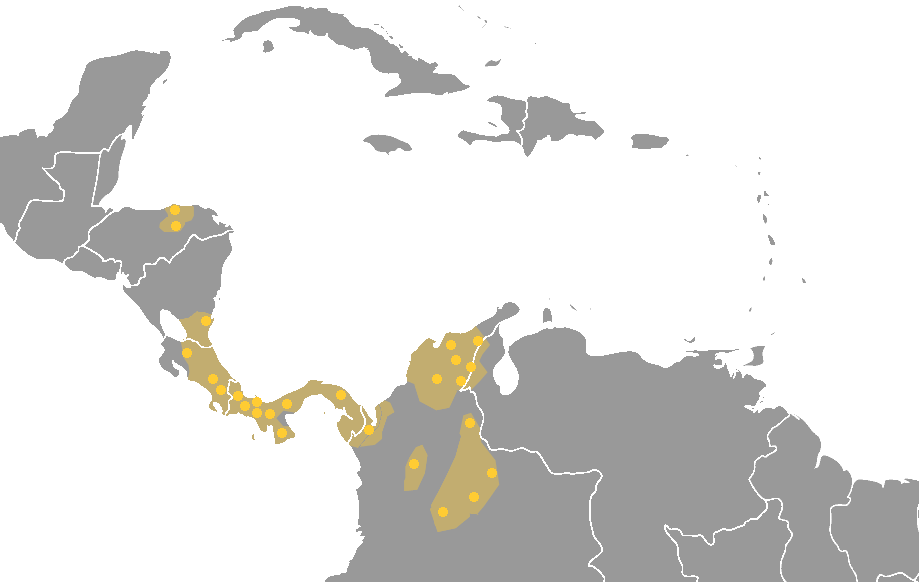Intermediate Area on:
[Wikipedia]
[Google]
[Amazon]
 The Intermediate Area is an
The Intermediate Area is an
 The Intermediate Area is an
The Intermediate Area is an archaeological
Archaeology or archeology is the study of human activity through the recovery and analysis of material culture. The archaeological record consists of Artifact (archaeology), artifacts, architecture, biofact (archaeology), biofacts or ecofacts, ...
geographical area
In geography, regions, otherwise referred to as areas, zones, lands or territories, are portions of the Earth's surface that are broadly divided by physical characteristics ( physical geography), human impact characteristics ( human geography), ...
of the Americas
The Americas, sometimes collectively called America, are a landmass comprising the totality of North America and South America.'' Webster's New World College Dictionary'', 2010 by Wiley Publishing, Inc., Cleveland, Ohio. When viewed as a sin ...
that was defined in its clearest form by Gordon R. Willey in his 1971 book ''An Introduction to American Archaeology, Vol. 2: South America'' (Prentice Hall: Englewood Cliffs, NJ). It comprises the geographical region between Mesoamerica
Mesoamerica is a historical region and cultural area that begins in the southern part of North America and extends to the Pacific coast of Central America, thus comprising the lands of central and southern Mexico, all of Belize, Guatemala, El S ...
to the north and the Central Andes
The Andes ( ), Andes Mountains or Andean Mountain Range (; ) are the List of longest mountain chains on Earth, longest continental mountain range in the world, forming a continuous highland along the western edge of South America. The range ...
to the south, including portions of Honduras
Honduras, officially the Republic of Honduras, is a country in Central America. It is bordered to the west by Guatemala, to the southwest by El Salvador, to the southeast by Nicaragua, to the south by the Pacific Ocean at the Gulf of Fonseca, ...
and Nicaragua
Nicaragua, officially the Republic of Nicaragua, is the geographically largest Sovereign state, country in Central America, comprising . With a population of 7,142,529 as of 2024, it is the third-most populous country in Central America aft ...
and most of the territory of the republics of Costa Rica
Costa Rica, officially the Republic of Costa Rica, is a country in Central America. It borders Nicaragua to the north, the Caribbean Sea to the northeast, Panama to the southeast, and the Pacific Ocean to the southwest, as well as Maritime bo ...
, Panama
Panama, officially the Republic of Panama, is a country in Latin America at the southern end of Central America, bordering South America. It is bordered by Costa Rica to the west, Colombia to the southeast, the Caribbean Sea to the north, and ...
and Colombia
Colombia, officially the Republic of Colombia, is a country primarily located in South America with Insular region of Colombia, insular regions in North America. The Colombian mainland is bordered by the Caribbean Sea to the north, Venezuel ...
. As an archaeological concept, the Intermediate Area has always been somewhat poorly defined.
Because it was not home to ancient state societies but was predominated by early chiefdom
A chiefdom is a political organization of people representation (politics), represented or government, governed by a tribal chief, chief. Chiefdoms have been discussed, depending on their scope, as a stateless society, stateless, state (polity) ...
s at the time of the Spanish conquest
The Spanish Empire, sometimes referred to as the Hispanic Monarchy or the Catholic Monarchy, was a colonial empire that existed between 1492 and 1976. In conjunction with the Portuguese Empire, it ushered in the European Age of Discovery. It ...
, it was sometimes regarded as a kind of cultural backwater that contributed little to the emergence of Pre-Columbian
In the history of the Americas, the pre-Columbian era, also known as the pre-contact era, or as the pre-Cabraline era specifically in Brazil, spans from the initial peopling of the Americas in the Upper Paleolithic to the onset of European col ...
civilization in the New World
The term "New World" is used to describe the majority of lands of Earth's Western Hemisphere, particularly the Americas, and sometimes Oceania."America." ''The Oxford Companion to the English Language'' (). McArthur, Tom, ed., 1992. New York: ...
. However, recent archaeological research has demonstrated that this part of the Americas had some of the earliest agriculture, pottery, and metallurgy in the hemisphere.
Given new findings, it is likely to have played a critical role in the transmission of culture both to and between neighboring regions to the north and south. Recently, concepts such as that of the Isthmo-Colombian Area have been offered as an alternative to the Intermediate Area with the intention of creating a neutral term.
References
* * * * * * {{refend Archaeology in the Americas Pre-Columbian cultural areas